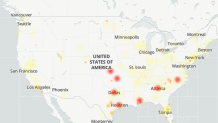A massive AT&T service outage caused more than 70,000 people across the country to lose service for hours Thursday, with hundreds of thousands of phones displaying an SOS message until service was finally restored.
In a statement Thursday afternoon, AT&T confirmed that service had been restored, more than 10 hours after the outages were first reported. "Keeping our customers connected remains our top priority, and we are taking steps to ensure our customers do not experience this again in the future," the statement said.
Later Thursday, NBC News reported that AT&T blamed the outage on an error in coding, without elaborating.
“Based on our initial review, we believe that today’s outage was caused by the application and execution of an incorrect process used as we were expanding our network, not a cyber attack,” the Dallas-based company said.
Feeling out of the loop? We'll catch you up on the Chicago news you need to know. Sign up for the weekly Chicago Catch-Up newsletter here.
But that didn't stop other theories from sweeping the internet -- one of which was particularly out of this world: that a solar flare was responsible for the massive outage.
NBC 5 Meteorologist Kevin Jeanes reported a total of three "solar flares" -- a release of x-rays and energy from the sun -- occurred in the last three days, with the biggest flare taking place early Thursday morning.
"The energy exits the sun at the speed of light in all different directions, reaching the Earth in about eight minutes," Jeanes said. He added that solar flares and Coronal Mass Ejections, which create Aurora, or the Northern Lights, can sometimes occur together. This time though, they didn't.
Local
"CMEs are responsible for creating the Northern Lights by interacting with Earth’s magnetic field," Jeanes said. "In this case, NOAA says no CMEs were observed."
According to NOAA, the sun emitted two strong solar flares Wednesday and Thursday, both with an R3 intensity on NOAA's five-level scale. The first one peaked at 5:07 p.m. CST on Wednesday, NOAA said. The second peaked at 1:32 a.m. CST early Thursday morning.
Reports of AT&T's service disruption began showing in Downdetector.com around 3:30 a.m. Thursday.
Jeanes noted that the Earth is entering "peak activity" of our current solar cycle -- a cycle of sunspot activity that lasts roughly 11 years. AR3590, a giant sunspot, has produced multiple X-class solar flares in the past 48 hours, Jeanes said.
They also have the capacity to cause temporary or complete loss of some high frequency signals, NOAA added, though it's "unlikely" this contributed to the outage.
"While solar flares can affect the communication systems, radar and the Global Positioning System, based on the intensity of these eruptions and associated phenomena, it is unlikely that these flares contributed to the widely reported cellular network outage," a statement from NOAA's Space Weather Prediction Center said.
Jeanes added that it's also unlikely such a flare would only impact a single service provider.
"I don't think solar flares are picking out individual networks," Jeanes said.
According to Jeanes, NOAA's forecast shows an increase in solar flare activity -- even the potential for Northern Light-producing CMEs as sunspot AR3590 turns more towards Earth.
"You may even be able to see the sunspot without a telescope, if you have solar eclipse glasses," Jeanes said, stressing that eclipse glasses must be used in order to look at the sun. "The dark sunspot is currently larger than Earth, and is in the upper left side of the sun."
Where were AT&T outages reported?
Thursday, Downdetector.com, a website that tracks outages, showed that the cities reporting the most outages were Los Angeles, Dallas, Indianapolis, Chicago, Houston, San Antonio, Louisville, Atlanta and Miami. More than 1,000 outages were reported in the Chicago area, the site reported.

The website also showed Verizon and T-Mobile customers were also facing massive outages.
A spokesman for Verizon told NBC News that they don't see any issues on their network and believes the problem is with other carriers. Verizon customers are only having issues when trying to call a number that is associated with one of the impacted carriers, the spokesperson said.
In an email to NBC Chicago, T-Mobile said their network was "operating normally," and that outages reported on Downdetector were likely reflecting T-Mobile customers attempting to reach users in other networks.
The outage, which began around 3:30 a.m. Thursday, also impacted 911 in some Chicago suburbs, including Evanston, Naperville and parts of Lake County.
"A systemwide outage is affecting AT&T and some other cellphone users, including the ability to call 911," the Lake County Sheriff's office posted on social media. "In case of an emergency, please attempt to use another phone with service or a landline until service providers can restore connectivity across the United States."
Other municipalities reported the same.
"A cellular outage in the United States was reported by AT&T, T-Mobile, Verizon and other network users on Thursday," a tweet from the Cape Girardeau, Missouri Police Department said early Thursday, adding that the outage was impacting their phone system.
A similar tweet was sent by the Flager County Sheriff's Office in Northeast Florida.
The Chicago Police Department confirmed to NBC Chicago that 911 services had not been impacted by the outages.
AT&T confirmed service had been restored around 2 p.m. Thursday.



